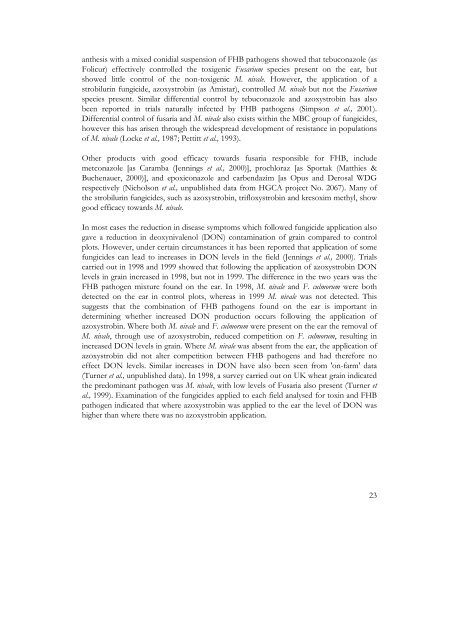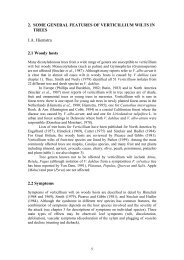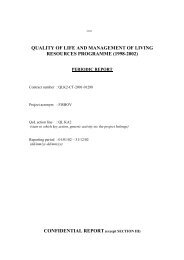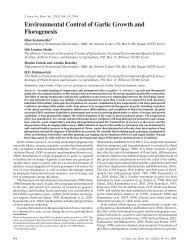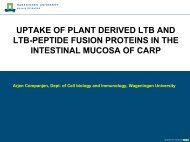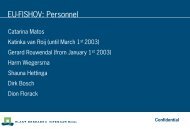3. Fusarium mycotoxins in cereals - Plant Research International ...
3. Fusarium mycotoxins in cereals - Plant Research International ...
3. Fusarium mycotoxins in cereals - Plant Research International ...
Create successful ePaper yourself
Turn your PDF publications into a flip-book with our unique Google optimized e-Paper software.
anthesis with a mixed conidial suspension of FHB pathogens showed that tebuconazole (as<br />
Folicur) effectively controlled the toxigenic <strong>Fusarium</strong> species present on the ear, but<br />
showed little control of the non-toxigenic M. nivale. However, the application of a<br />
strobilur<strong>in</strong> fungicide, azoxystrob<strong>in</strong> (as Amistar), controlled M. nivale but not the <strong>Fusarium</strong><br />
species present. Similar differential control by tebuconazole and azoxystrob<strong>in</strong> has also<br />
been reported <strong>in</strong> trials naturally <strong>in</strong>fected by FHB pathogens (Simpson et al., 2001).<br />
Differential control of fusaria and M. nivale also exists with<strong>in</strong> the MBC group of fungicides,<br />
however this has arisen through the widespread development of resistance <strong>in</strong> populations<br />
of M. nivale (Locke et al., 1987; Pettitt et al., 1993).<br />
Other products with good efficacy towards fusaria responsible for FHB, <strong>in</strong>clude<br />
metconazole [as Caramba (Jenn<strong>in</strong>gs et al., 2000)], prochloraz [as Sportak (Matthies &<br />
Buchenauer, 2000)], and epoxiconazole and carbendazim [as Opus and Derosal WDG<br />
respectively (Nicholson et al., unpublished data from HGCA project No. 2067). Many of<br />
the strobilur<strong>in</strong> fungicides, such as azoxystrob<strong>in</strong>, trifloxystrob<strong>in</strong> and kresoxim methyl, show<br />
good efficacy towards M. nivale.<br />
In most cases the reduction <strong>in</strong> disease symptoms which followed fungicide application also<br />
gave a reduction <strong>in</strong> deoxynivalenol (DON) contam<strong>in</strong>ation of gra<strong>in</strong> compared to control<br />
plots. However, under certa<strong>in</strong> circumstances it has been reported that application of some<br />
fungicides can lead to <strong>in</strong>creases <strong>in</strong> DON levels <strong>in</strong> the field (Jenn<strong>in</strong>gs et al., 2000). Trials<br />
carried out <strong>in</strong> 1998 and 1999 showed that follow<strong>in</strong>g the application of azoxystrob<strong>in</strong> DON<br />
levels <strong>in</strong> gra<strong>in</strong> <strong>in</strong>creased <strong>in</strong> 1998, but not <strong>in</strong> 1999. The difference <strong>in</strong> the two years was the<br />
FHB pathogen mixture found on the ear. In 1998, M. nivale and F. culmorum were both<br />
detected on the ear <strong>in</strong> control plots, whereas <strong>in</strong> 1999 M. nivale was not detected. This<br />
suggests that the comb<strong>in</strong>ation of FHB pathogens found on the ear is important <strong>in</strong><br />
determ<strong>in</strong><strong>in</strong>g whether <strong>in</strong>creased DON production occurs follow<strong>in</strong>g the application of<br />
azoxystrob<strong>in</strong>. Where both M. nivale and F. culmorum were present on the ear the removal of<br />
M. nivale, through use of azoxystrob<strong>in</strong>, reduced competition on F. culmorum, result<strong>in</strong>g <strong>in</strong><br />
<strong>in</strong>creased DON levels <strong>in</strong> gra<strong>in</strong>. Where M. nivale was absent from the ear, the application of<br />
azoxystrob<strong>in</strong> did not alter competition between FHB pathogens and had therefore no<br />
effect DON levels. Similar <strong>in</strong>creases <strong>in</strong> DON have also been seen from 'on-farm' data<br />
(Turner et al., unpublished data). In 1998, a survey carried out on UK wheat gra<strong>in</strong> <strong>in</strong>dicated<br />
the predom<strong>in</strong>ant pathogen was M. nivale, with low levels of Fusaria also present (Turner et<br />
al., 1999). Exam<strong>in</strong>ation of the fungicides applied to each field analysed for tox<strong>in</strong> and FHB<br />
pathogen <strong>in</strong>dicated that where azoxystrob<strong>in</strong> was applied to the ear the level of DON was<br />
higher than where there was no azoxystrob<strong>in</strong> application.<br />
23


